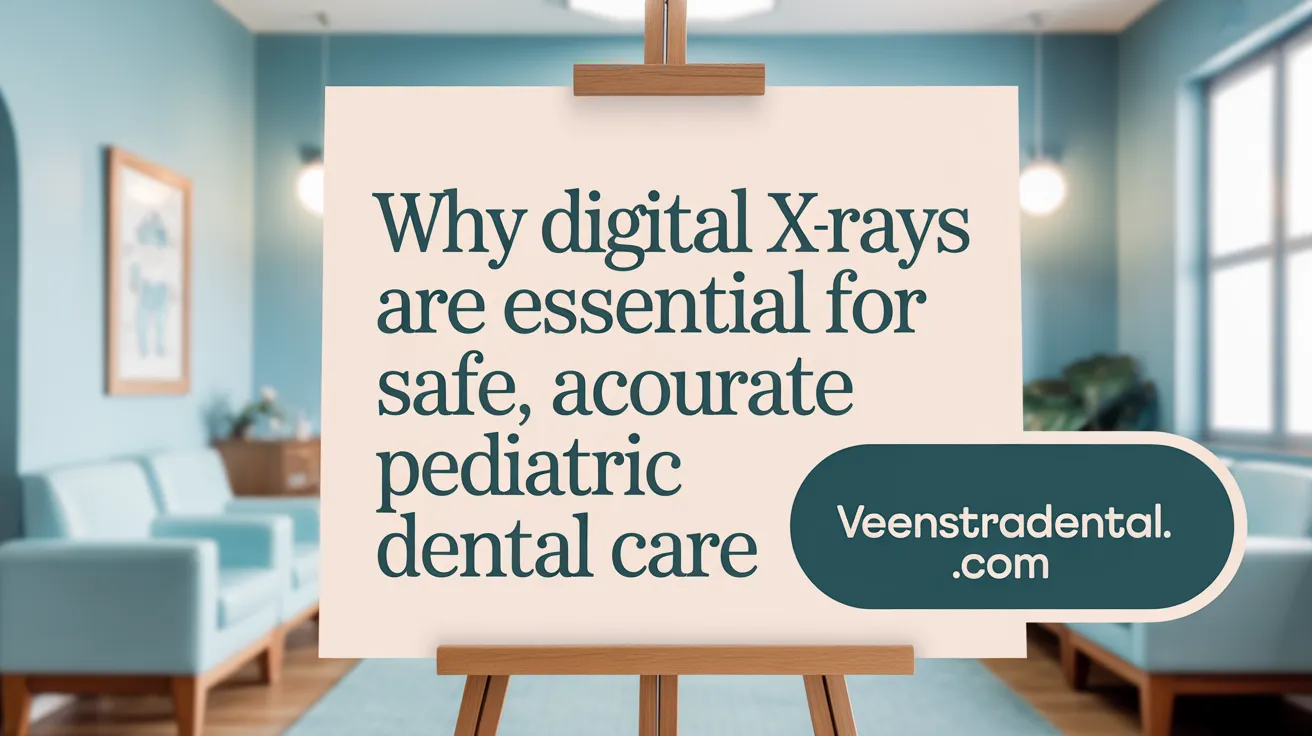Beyond the Surface: Seeing What Brushing Misses
While daily brushing keeps our teeth visibly clean, many dental issues lurk beneath the surface, invisible to the naked eye and routine examination. Digital X-ray technology illuminates these hidden concerns, offering dentists a powerful diagnostic tool that reveals what brushing and visual checks cannot. This article explores how digital X-rays revolutionize dental care by enhancing early detection, improving safety, and providing detailed insights essential for comprehensive oral health management.
Enhancing Dental Diagnostics: How Digital X-Rays Improve Oral Health
How do digital X-rays improve dental diagnostics and overall oral health?
Digital X-rays have transformed dental diagnostics by offering high-resolution images that reveal hidden dental issues more clearly than traditional film X-rays. These advanced images help dentists identify cavities, infections, gum disease, tumors, and other abnormalities early, often before symptoms appear.
The immediate display of digital X-ray images on a computer monitor allows for quick diagnosis and treatment planning. Dentists can zoom in and modify the images for better clarity, ensuring no detail is overlooked. This technology not only improves accuracy but also reduces the need for invasive procedures, leading to more conservative and less painful treatments.
An additional advantage is the remarkable reduction in radiation exposure—up to 70% less than traditional X-rays—making the process safer, especially for children and pregnant women. Digital X-rays are environmentally friendly, eliminating the harmful chemicals used in film processing. They also support efficient record management through electronic storage, enabling easy sharing with specialists or insurance companies.
Overall, digital X-rays enhance early detection and precise diagnosis. This results in better oral health outcomes, improved patient understanding, and more effective treatment strategies.
Advantages Over Traditional Imaging Methods
 Digital dental X-rays provide several benefits compared to traditional film-based imaging. One of the main advantages is their ability to produce high-resolution, detailed images that can be easily enlarged or adjusted. This clarity helps dentists identify tiny decay, early infections, or small fractures that might be missed with less detailed images.
Digital dental X-rays provide several benefits compared to traditional film-based imaging. One of the main advantages is their ability to produce high-resolution, detailed images that can be easily enlarged or adjusted. This clarity helps dentists identify tiny decay, early infections, or small fractures that might be missed with less detailed images.
Radiation exposure is significantly lower with digital X-rays—up to 70-90% less—compared to traditional film X-rays. This reduction makes the procedure safer, especially for children, pregnant women, and patients requiring frequent imaging.
Another benefit is the immediacy of results. Digital X-ray images are displayed on a monitor within seconds, allowing dentists to quickly assess and explain findings to patients during the same visit. The digital format also facilitates easy electronic storage and sharing of images, improving coordination among healthcare providers and simplifying record keeping.
Environmentally, digital X-rays are more sustainable because they eliminate the need for chemical processing used in film development. This change reduces hazardous waste and minimizes environmental impact.
In summary, digital X-ray technology enhances safety, accuracy, efficiency, and environmental sustainability, making it a superior choice over traditional methods.
| Feature | Traditional X-ray | Digital X-ray | Additional Details |
|---|---|---|---|
| Image resolution | Good but limited | High-resolution, adjustable | Better for detecting early or subtle issues |
| Radiation exposure | Higher (up to 90%) | Up to 90% reduction | Safer, especially for vulnerable groups |
| Viewing time | Delay (chemical development) | Instantaneous display | Facilitates immediate diagnosis |
| Storage and sharing | Physical or scanned images | Electronic, easily sharable | Enhances collaboration and record management |
| Environmental impact | Chemical processing required | No chemicals, eco-friendly | Less hazardous waste and chemical use |
This comparison underscores how digital X-rays improve diagnostic accuracy while prioritizing patient safety and environmental health.
Detecting What Brushing and Routine Exams Miss
 Digital X-rays play a crucial role in uncovering early and hidden dental issues that physical examinations or routine brushing cannot detect. Thanks to their high-resolution imaging, these scans reveal problems lying beneath surface-level inspections.
Digital X-rays play a crucial role in uncovering early and hidden dental issues that physical examinations or routine brushing cannot detect. Thanks to their high-resolution imaging, these scans reveal problems lying beneath surface-level inspections.
One common issue identified through digital X-rays is cavities hidden between teeth. These are often missed during visual checks because they exist beneath the enamel surface. Similarly, infections at the root tips and abscesses, which are deep-seated and not visible externally, can be accurately pinpointed.
Bone loss and early signs of periodontal disease are also challenging to detect through routine exams. Digital X-rays make it possible to observe changes in jawbone density and structure, facilitating early intervention before extensive damage occurs.
Impacted or unerupted teeth—teeth that are stuck or haven't emerged properly—are visible with panoramic or detailed intraoral scans. Identifying these issues early can prevent complications like misalignment or infections.
Another advantage is the ability to enlarge images and view them instantly during a dental appointment. This capacity allows both the dentist and patient to see fine details clearly, aiding in the early diagnosis of decay, cysts, or tumor formations.
Overall, these advanced imaging techniques provide a comprehensive view of dental health, revealing internal problems that would not be apparent through brushing or basic examination alone. This leads to more precise treatments and better long-term oral health outcomes.
For those interested, searching
Safety and Technology: How Digital X-Rays Protect Patients While Enhancing Diagnostics

What are the safety features and technological functions of digital X-rays used in dentistry?
Digital dental X-rays are equipped with advanced sensors and sophisticated imaging software that greatly improve the diagnostic process. These sensors capture high-resolution images of teeth, gums, and jaw structures almost instantly, allowing dentists to conduct quick, detailed examinations.
One of the most notable technological benefits of digital X-rays is their ability to significantly reduce radiation exposure—by up to 90% compared to traditional film X-rays. This drastic decrease enhances patient safety, especially important for children, pregnant women, and individuals requiring frequent imaging.
The images produced are displayed immediately on a computer screen, aiding rapid diagnosis and enabling real-time discussions during appointments. The software also allows for easy enhancement of images—such as zooming in or adjusting brightness and contrast—improving the detection of early or subtle dental issues.
Furthermore, digital X-rays eliminate the need for chemical processing used with traditional film, making the procedure more environmentally friendly. The quick availability of results and the ability to compare images over time bolster effective treatment planning.
Despite the safety benefits, it is important to remember that digital X-rays do involve some radiation exposure. Medical guidelines suggest that the exposure is generally minimal and justified by the diagnostic benefits, contributing to safer, more accurate dental care for patients.
| Feature | Description | Additional Benefits |
|---|---|---|
| Advanced Sensors | Capture high-resolution images instantly | Better detail, early detection |
| Imaging Software | Enhance and compare images easily | Improved diagnosis and communication |
| Radiation Dose | Up to 90% less than traditional X-rays | Safer for patients, especially children and pregnant women |
| Immediate Results | Display images within seconds | Quick treatment decisions |
| No Chemicals Needed | Digital images stored electronically | Environmentally friendly |
In summary, digital X-rays combine cutting-edge sensor technology and imaging software to provide safer, faster, and more detailed dental diagnostics—a true advancement in dental healthcare.
Applications in Dental Care: Detecting Cavities and Assessing Oral Health
How are digital X-rays applied in dental care for detecting cavities and assessing oral health?
Digital X-rays play a vital role in modern dentistry, offering detailed insights into a patient’s oral structures. They enable dentists to efficiently identify hidden cavities, decay, infections, and other abnormalities that are not visible during a regular examination.
There are two main types of digital X-rays: intraoral and extraoral.
- Intraoral X-rays include bitewing, periapical, and occlusal images, which focus on individual teeth, roots, and surrounding bone.
- Extraoral X-rays, such as panoramic and cone beam CT scans, capture broader views of the entire mouth and jaw.
These high-resolution images rapidly reveal issues like cavities beneath fillings, bone loss, impacted teeth, cysts, and tumors. The use of digital sensors reduces radiation exposure by up to 80-90% compared to traditional film X-rays, making the procedure safer.
Instant digital images allow for quick diagnosis, giving dentists the ability to plan effective treatments immediately. They also aid in monitoring the progression of dental conditions over time, ensuring timely interventions.
Overall, digital X-rays are indispensable in providing precise, safe, and efficient dental assessments that improve patient outcomes and support early detection of problems.
Pediatric Dentistry: Ensuring Safe and Effective Diagnostics for Children

Why are digital X-rays important in pediatric dentistry and comprehensive dental diagnostics?
Digital X-rays play a crucial role in pediatric dentistry due to their ability to significantly reduce radiation exposure—by up to 80% compared to traditional film X-rays. This lower radiation dose is especially important for children, who are more sensitive to radiation risks.
These advanced imaging techniques produce high-quality, detailed images instantly, which helps in early detection of various dental issues. Dentists can identify cavities, developmental abnormalities, impacted teeth, and infections before they become more serious, enabling early and effective intervention.
The high resolution and clarity of digital X-rays support precise treatment planning. They also allow for better monitoring of dental development over time, helping catch changes or problems early.
Digital X-rays simplify record keeping through electronic storage, making it easy to share images with other healthcare providers or with parents. This improves communication, ensuring everyone understands the dental health status and treatment options.
In summary, digital X-rays are an invaluable tool in pediatric dentistry because they enhance diagnostic accuracy while prioritizing safety. They facilitate early diagnosis, support treatment strategies, and promote ongoing care—ultimately leading to healthier smiles for children.
Digital X-Rays and Patient Engagement: Immediate Visualization and Education
How do digital X-rays display images instantly?
Digital X-ray machines capture high-resolution images using electronic sensors placed inside the mouth or around the area of concern. These sensors transmit the images immediately to a connected computer, where they appear on the screen within seconds. This rapid process allows the dentist to analyze the images right away, speeding up diagnosis and treatment planning.
Can images be enlarged or adjusted?
Yes, digital X-ray images can be enlarged, zoomed in, or adjusted for brightness and contrast. These features help dentists examine tiny details, such as early decay or small fractures, with greater clarity. Enhanced images give a more accurate view of dental health issues that might be missed with standard viewing.
How do digital X-rays improve patient understanding?
Visualizing issues directly on a screen helps patients better grasp their dental conditions. Seeing their own X-ray images makes explanations more concrete, which may increase trust and compliance. This immediate visual feedback can motivate patients to follow recommended treatments and preventive measures.
How are digital X-rays used to explain treatment options?
Dentists can use clear, detailed images to show the extent of cavities, infections, or other concerns. By pointing out specific areas on the screen, they help patients understand what needs to be fixed, why, and how treatment will proceed. This visual approach demystifies procedures and encourages cooperation.
What role do digital X-rays play in pediatric and parental involvement?
For children, viewing images on a monitor can make the visit more engaging and less intimidating. Parents also appreciate being able to see issues directly, which helps them understand the importance of dental visits and follow-up care. Digital images support education and consent, fostering a collaborative environment in pediatric dental care.
Comprehensive Diagnostics with Advanced Imaging Technologies

What types of digital X-rays are used in dentistry?
Digital dental X-rays come in various forms, each suited for specific diagnostic needs. Intraoral X-rays include bitewing, periapical, and occlusal images, which provide close-up views of teeth and surrounding bone. Extraoral X-rays like panoramic, cephalometric, and cone beam CT scans offer broader views of the entire mouth, jawbones, and skull structures, allowing for more comprehensive assessments.
How does 3D imaging benefit dental diagnosis?
Three-dimensional (3D) digital imaging, especially CBCT (cone beam computed tomography), provides detailed, high-resolution images that reveal complex structures within the mouth. This enhances the detection of hidden abnormalities, precise treatment planning, and monitoring of growth and healing. 3D imaging helps detect issues like impacted teeth, bone loss, and airway obstructions more accurately than traditional 2D X-rays.
Can digital X-rays help identify complex conditions?
Yes, digital X-rays are highly effective in identifying challenging conditions such as cysts, tumors, and infections. They can also reveal impacted or unerupted teeth, fractures, and developmental abnormalities. Additionally, advanced scans can assess airway obstructions, which might affect breathing or sleep, offering insights into systemic health concerns related to oral conditions.
How does digital imaging support a broader health assessment?
Digital X-rays improve understanding of oral health in relation to overall well-being. They help in early detection of oral diseases, which can be linked to systemic issues like cardiovascular disease or diabetes. The detailed images facilitate holistic health evaluations, guiding comprehensive treatment strategies that benefit both oral and general health.
What are the environmental advantages of digital imaging?
Compared to traditional film X-rays, digital images eliminate the need for chemical processing, reducing environmental pollution. Digital systems also use up to 90% less radiation, enhancing patient safety. These eco-friendly benefits align with sustainable healthcare practices, making digital dental imaging a responsible choice for modern clinics.
The Future of Dental Health Through Digital Imaging
Digital X-rays have transformed dental diagnostics by revealing the unseen and providing a safer, faster, and more precise method to assess oral health beyond what daily brushing and visual exams can detect. Their ability to reduce radiation exposure, deliver instant high-resolution images, and support early intervention empowers both dentists and patients to maintain healthier smiles. Especially in pediatric care, their gentler approach fosters confidence and cooperation. As technology continues to evolve, digital imaging stands as a cornerstone of comprehensive, environmentally conscious dental care that uncovers and addresses issues before they escalate. Embracing digital X-rays means embracing a future where oral health is safeguarded with clarity and care beyond the surface.
References
- How Digital Dental X-Rays Enhance Your Oral Care
- Dental X-rays: Purpose & Types
- Dental Digital X-Rays: Future of Smarter Dental Treatment
- Dental diagnostics: How do digital X-rays work, and why ...
- Benefits of Digital X-Rays and Intraoral Camera Exams
- What Are Digital X-Rays? Are They Safer Than Film X-Rays?
- Digital X-Rays
